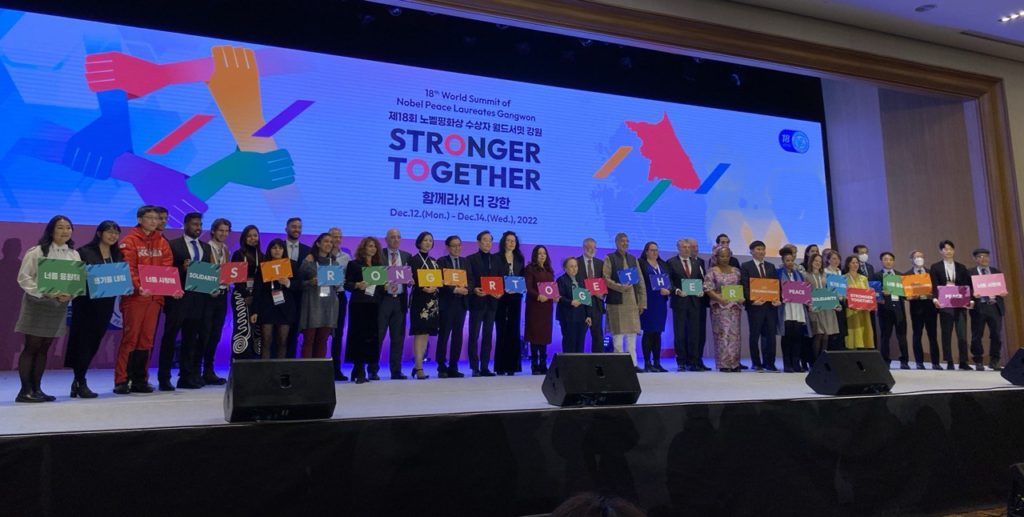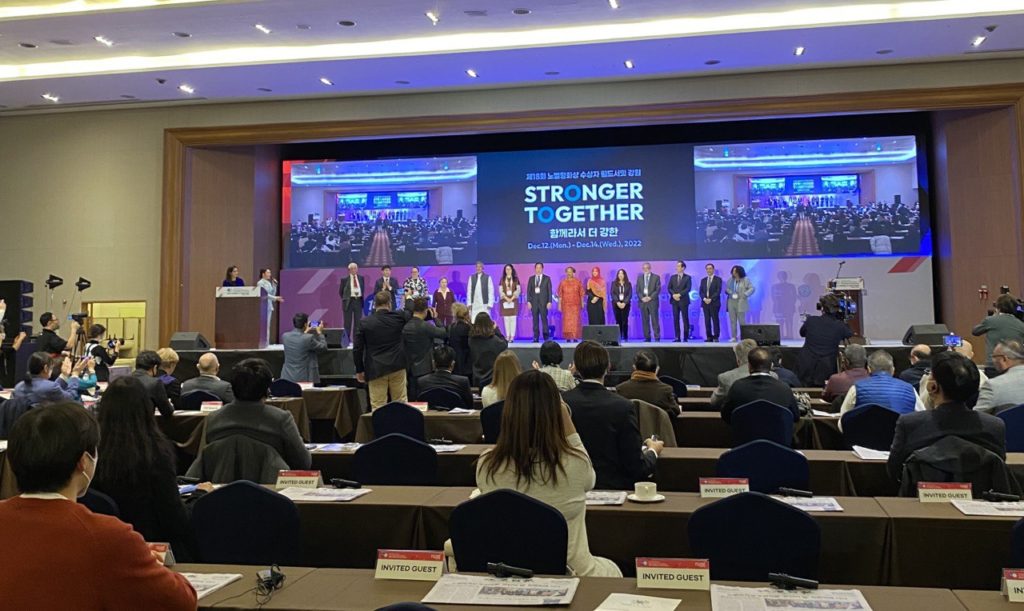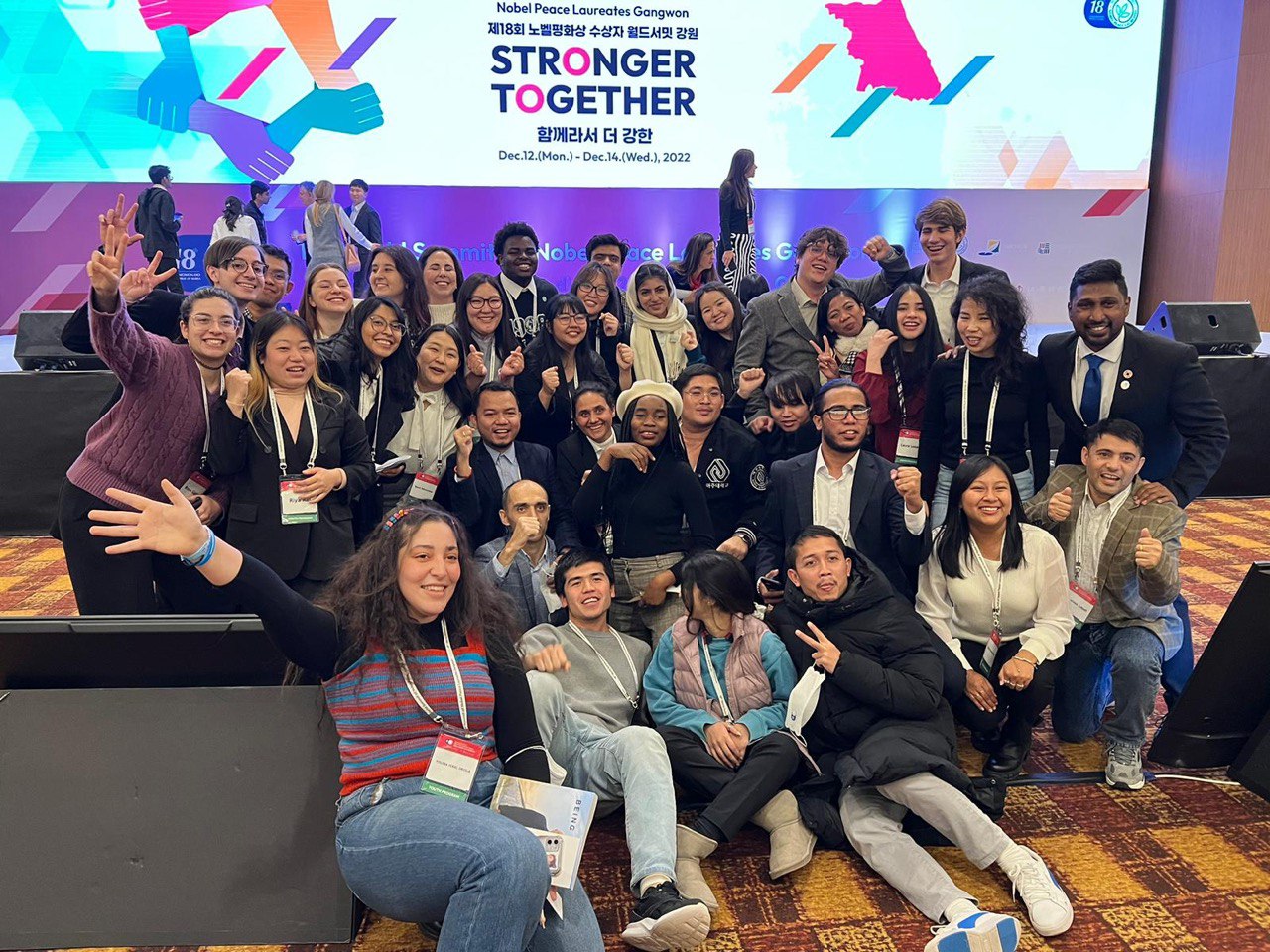World Summit of Nobel Peace Laureates: Maybe We Can Change the World with a Pen and a Pad
By Yousra Feriel Drioua
“Let go of your pre-existing prejudices and beliefs concerning the discussions we’ll be having during the summit.” These words are quoted from the welcoming speech of the 18th World Summit of Nobel Peace Laureates (WSNPL) by its president, Ekaterina Zagladina. Packed with a variety of seminars, workshops, panels, and thematic forums under the theme of “Stronger Together,” the 18th WSNPL was held in Pyeongchang, South Korea, at the Alpensia Convention Center last December 12–14.
This year under the slogan of “Leading by Example,” it welcomed over 200 student attendees from 47 countries of different academic backgrounds, pushing for the inclusion of youth in the “making” of peace and involvement in the political sphere. The summit had three programs: The general one was for social activists and peace enthusiasts of all ages. The Press Program, was joined by both junior and senior journalists officially affiliated with a media entity. And the one I was a part of was the Youth Program.

The WSNPL earned the label of “world” in its name. The sheer differences between people present there almost forced us to adapt new mindsets to “co-exist.” One could disagree with others but had no liberty to force said others to abide by one’s rules: Both freedoms were assured by peace. That is poetic to me. It was one of the rarest occasions where religions were discussed based on curiosity and a seeking of understanding rather than disdain. It allowed for an open conversation about different perspectives on the queer community, where no side was persuading the other and ensuring an environment for genuine bonding between participants. I sincerely believe that if one really opened their hearts during the summit, they wouldn’t have left the same person they came as. Sure, three days is a short period of time, and people do not change that easily. But a combination of embracing hearts and flexible minds guarantee boundless room for growth and change. At least, they pave the way for the latter.
Speaking of embracing, the WSNPL brought two artists from Ukraine and Russia to create a painting for the closing ceremony. The artists, with the participants, made a raw piece of art. I refer to it as such because of the inspiration behind it. The artists had already done some work on the canvas; however, it was blank. Why? The participants were meant to create their respective “ideal world,” and altering it throughout the summit. Looking at a blank canvas with this perspective in mind should inspire, dare I say, even a philistine to grab a brush to at least make a stroke. One could learn and develop their idea as they mixed the palette colors. Again, this is an anecdote from the summit.
What the summit is notable for is the participation of Nobel Peace Laureates. Besides the background differences they share, it was their opposing mindsets that left me in awe. For example, Tawakkol Karman finds that in a united world, nations have a responsibility to fulfill: that at some point they must get involved in each other’s matters if it concerns peace. Other laureates such as Shirin Ebadi were almost entirely opposed to this. I appreciate that it opens doors for inclusivity in the thought process, which cranks the policymaking. At the end of the day, the laureates’ views on the world may not be the same, but they were united with two qualities: speaking from personal experience and preaching for peace. Whilst many young participants perhaps saw themselves more like the sterner laureates, I was moved to tears by Leymah Gbowee when she said, “We must re-imagine peace through sensitivity and human emotions, for that is the humanitarian perspective of peace.” It inspired me to continue being “sentimental” and “emotional” in my individual pursuit of justice.

Another thing to note from the summit was PeaceLab, a forum that brings together youth, academics, organizations, and experts from around the globe to propose and discuss implementation of programs and projects addressing challenges in their communities with the end goal of positive social change. The topics varied from civil rights to economy, technology, and sports as tools for building diplomacy peacefully. The one that left an imprint on me was the Social Justice Desk’s workshop, “Everyday Activism is the Key to Empowerment, Justice, and Sustainable Development.”
Overall, if we are to be frank, the summit cannot create the change we seek to see in the world nor can it implement peace. Its importance lies in the fact that it provides a pedestal for unity. People of all ages and of all spectrums of life gathering together can generate powerful elements. These elements can go from revolutionary ideas to sheer influence – both assuring a force not to be reckoned with. What’s that force? It is a complex, rather bittersweet mixture of anger and hope.
Ultimately, since world peace is too unordinary for our current state, what the World Summit of Nobel Peace Laureates can implement is in fact a positive impact on ordinary people, for it is they who have been bringing visions to life for decades – ordinary people, who dedicate their lives to the causes they believe in and, in return, inspire others to carry on their lifelong missions. Now, who is more capable of achieving the unordinary than ordinary people with burning hearts?
The Author
Yousra is a 23-year-old Algerian, currently residing in South Korea and majoring in mass communication and journalism. As she figures out her calling in life, she is mostly interested in writing, radio, and media. She enjoys intriguing conversations, meeting new people, and being an active community member. Oh, and she is a long-time member of the BTS Army. Instagram: @myyigli
Affiliated Links
The WSNPL: http://www.nobelpeacesummit.com/
The Social Justice Desk: https://www.justicedesk.org/







